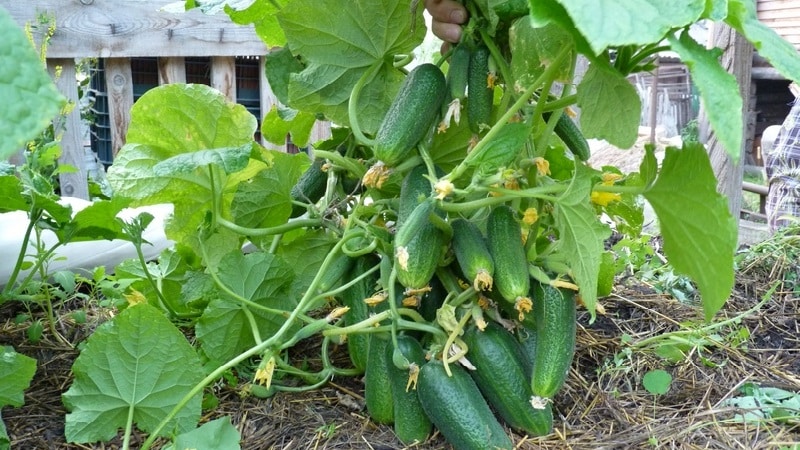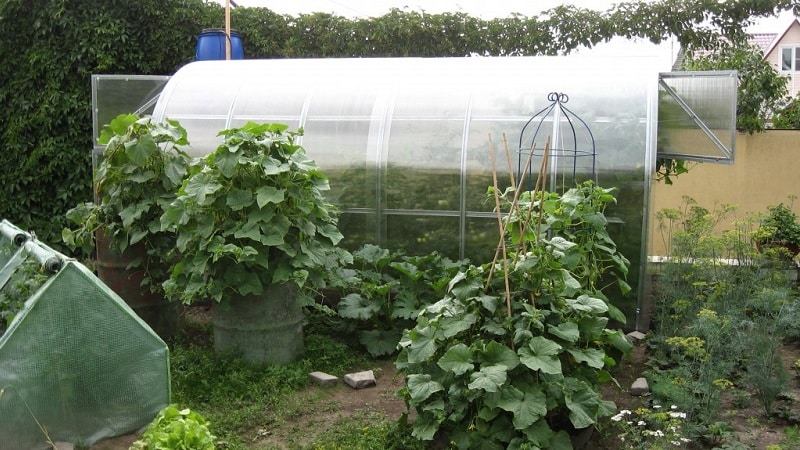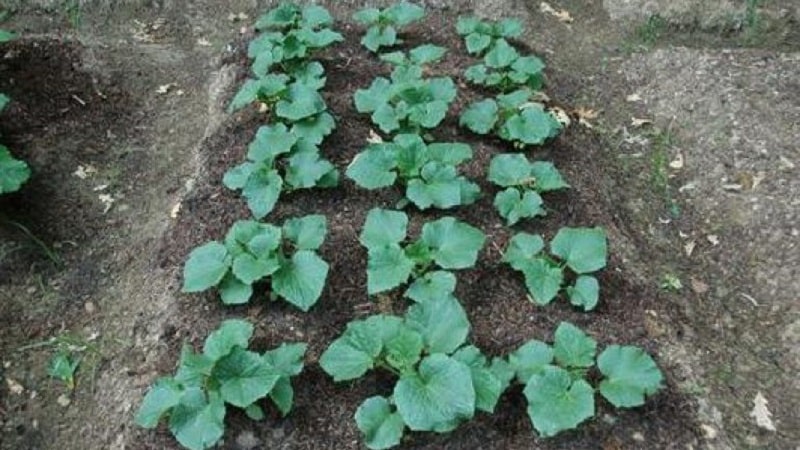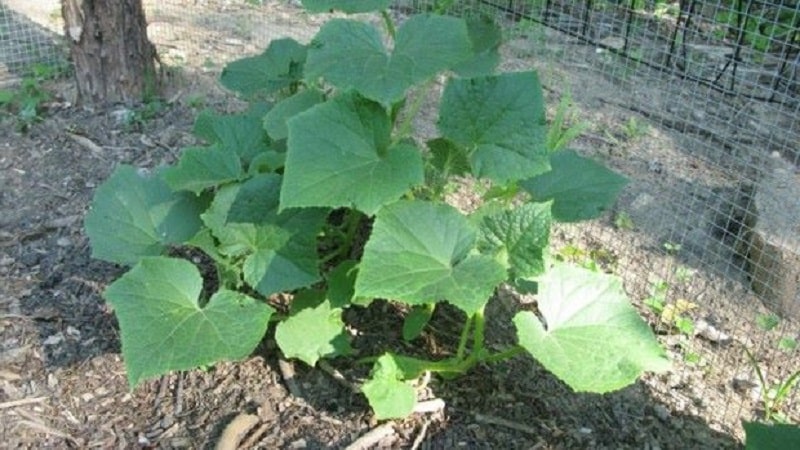Characteristics of bush cucumbers and cultivation features
Cucumbers are one of the most popular crops among gardeners in our country. Already in the second half of spring, you can try fresh fruits grown on your own, and the winter menu is not complete without pickled vegetables, so summer residents try to grow them in large quantities.
Not only owners of large plots can please themselves with a rich cucumber harvest. Using bush varieties, fruits can be collected even in small beds. What are the advantages of bush cucumbers and what are the nuances of caring for them, we will tell you further.
General description of bush cucumbers
Bush cucumbers are distinguished by their low growth of the main stem - 50 cm, while in classic varieties the main loops reach 3 m. Moreover, they have a minimum number of side branches. Thanks to this, these varieties are compact bushes.
Bush cucumbers have short internodes. Because of this, the plants appear heavily leafy. They produce a large number of fruits, the size of which reaches 10 cm, but they are usually removed from the bush when they reach 5 cm. They are convenient to preserve and look beautiful on the table.

All bush cucumbers are characterized by rapid and rapid ripening. Already 3 weeks after the appearance of the first shoots, the harvest is harvested. The growing season of bush cucumbers is also short. Already a month after the formation of the first fruits, the bushes are dug up and new plants are planted in their place.
The taste of cucumbers is rich, sweetish. They are crispy, have a tender skin and lots of bumps.
All bush varieties are resistant to most viral and fungal diseases. Thanks to the rapid setting of fruits, gardeners have time to harvest before the outbreak of the most common diseases.
This is interesting. Bush cucumbers are decorative and look interesting even in outdoor flowerpots.
Advantages and disadvantages of bush cucumbers
Bush cucumbers differ significantly from classical varieties in the type of bush.
They have many advantages:
- quick and friendly yield of the harvest;
- compactness;
- ease of care;
- immunity to many diseases of melons;
- small fruit sizes.
Disadvantages of bush cucumbers – low yield and short growing season.
Varieties of bush cucumbers
Introducing the most popular varieties of bush cucumbers:
- Mikrosha. Variety for open ground. The height of the bush reaches 40 cm. The fruits are egg-shaped and reach a length of 5 cm. The peel is dark green and dense. The seeds are small. The taste is sweetish. Has high immunity to viral and fungal diseases.
- Gift. Recommended for open ground. The bush reaches a height of 50 cm. It is resistant to viral and fungal diseases. Dark green fruits with thin skin grow up to 10 cm in length.
- Shorty. A bee-pollinated variety that is suitable for growing in open ground. The bush is medium spreading. The maximum height of the main stem reaches 45 cm. Zelentsy are light green, with white stripes and delicate, thin skin. The length of the fruit does not exceed 9 cm. It has high immunity to olive spot and powdery mildew.
- Bush. The height of the bush does not exceed 50 cm. The fruits are cylindrical, up to 8 cm long, green in color, with thin skin. They are distinguished by their ease.
The advantage of bush cucumber varieties is that collected seeds from self-grown fruits are suitable for planting. Planting material is collected from large, yellowed fruits on the bush.
Hybrids of bush cucumbers
Hybrids of bush cucumbers are often more resistant to diseases than varieties. Therefore, many gardeners prefer them:
- Sturdy baby F1. The height of the bush varies between 30-40 cm. The fruits are egg-shaped, weighing 60-80 g. Resistant to viral and fungal diseases.
- Baby F1. The height of the central stem reaches 30 cm. The fruits are elongated, dark green, with large tubercles. They reach a length of 9 cm. The hybrid is resistant to viruses and powdery mildew.
- Hector F1. The height of the bush reaches 40 cm. The light green fruits grow up to 8 cm in length, have a thin peel and light pubescence. The hybrid is resistant to cold weather.
- Aladdin F1. The maximum height of the bush is 70 cm. The cucumbers are elongated, dark green in color, with sparse tubercles. Each fruit reaches 10 cm in length. The hybrid is demanding on soil composition and watering. Is immune to downy mildew.
- Boy with Thumb F1. The height of the bush varies between 30-40 cm. The length of the dark green prickly fruits does not exceed 8 cm. It is immune to viral and fungal diseases.
Seeds from hybrid fruits are not used for planting. Often, they grow into plants that have parental rather than hybrid characteristics.

Planting cucumbers
Bush planting self-pollinating varieties cucumbers for open ground are not much different from planting ordinary ones. Due to the compact size of the plants, they are planted close to each other..
Cucumbers are demanding on the composition of the soil. They begin preparing the beds for planting cucumbers in the fall.To do this, the soil is dug up and cleared of plant debris. For every 1 m², add 15 g of urea, 30 g of superphosphate and 6 kg of humus. The ingredients are mixed with soil.
In the spring the soil is dug up. For every 1 m², add a glass of ash to reduce acidity and saturate the soil with useful microelements. 2 days before planting cucumbers, water the soil with a hot solution of copper sulfate (1 tbsp. L of copper sulfate per bucket of water).
The choice of location for planting cucumbers also matters.. Semi-shaded areas where groundwater is not too close to the surface are suitable for this crop.
It is important to observe crop rotation. No other melon crops should grow in the selected area during the previous two years.
Bush cucumbers are grown in seedlings and without seedlings. In both cases, before using the planting material, it is prepared:
- Warming up. A month before planting, the package with seeds is placed near the battery.
- Calibration. The seeds are sorted out, leaving dense large specimens without damage, dark spots, or voids.
- Disinfection. The seeds are soaked for half an hour in a light pink solution of potassium permanganate or for 6 hours in a solution "Fitosporina".
- Stimulation of growth. Seeds are soaked for 6-12 hours in a growth stimulator. The products “Epin” and “Solution” are often used.
- Hardening. The seeds are placed in the refrigerator for a day.
After processing, the planting material is ready for planting.
Note! Often purchased planting material is processed in the factory. Information about this is indicated on the packaging.
Seedless method
Cucumbers are grown without seedlings in the southern regions. They are sown in the ground when the soil at a depth of 15 cm warms up to +12°C. This usually happens in early May.
Seeds are sown in rows to a depth of 4 cm. The distance between plants should be 20-25 cm, between rows - 40 cm. Some gardeners sow two seeds in one hole, and if both germinate, then pinch out the weaker plant.
After sowing the seeds, the beds are watered with warm water.. Next, the soil is moistened as it dries. The crops are covered with a film, which is opened slightly during the hottest part of the day and ventilated for two hours. After the first shoots appear, the beds are covered with film only at night. When the threat of night frosts has passed, it is completely removed.
For greenhouses, the principle of sowing seeds is the same. In this case, the cultivation of cucumbers begins in the second half of April. The crops are not covered with film.

Seedling method
Rassadny the method is considered the most reliable. It is suitable for growing cucumbers in all regions and allows you to get the harvest much earlier.
The timing of sowing seeds for seedlings depends on the region:
- southern - early April;
- central – second half of April;
- northern - early May.
Cucumbers do not tolerate picking well, so the seeds are sown immediately in separate containers. – plastic and peat cups are suitable. Before use, they are disinfected with a dark pink solution of potassium permanganate.
For cucumber seedlings, buy a universal soil mixture or prepare the soil yourself. To do this, mix two parts of garden soil and humus with one part of sawdust or sand. The earth is disinfected with a dark pink solution of potassium permanganate or calcined in the oven.
One seed is sown in each container, buried 2 cm. The crops are watered with warm water, covered with film and put in a place with a temperature of +24...+26°C.
When the seeds germinate, the film is removed. Plants are grown at room temperature. If there is not enough natural light, then use phytolamps.
How to care for seedlings:
- Seedlings are watered 2 times per week with water at room temperature. For watering use a spray bottle.
- After the appearance of two true leaves fertilize. It is prepared from 1 liter of water and 1 teaspoon of “Nitrophoska”.
- Two weeks after sowing the seeds, seedlings taken out into the street. Hardening begins at one hour, gradually increasing the time to 12 hours.
Seedlings are planted 3 weeks after sowing the seeds.. By this time, the soil temperature at a depth of 15 cm should reach +12°C.
Holes are dug in the ground using a 25x40 pattern. Seedlings are placed in them along with a lump of earth, without deepening the root collar.
After planting, the plants are watered. The next watering is possible no earlier than in a week.
For the first two weeks, cucumbers are covered with film at night.. This reduces the threat of plant death due to night frosts.
Rules for caring for bush cucumbers
It is believed that growing bush cucumbers is easier than climbing ones.. Caring for this type of culture has its own nuances.
Caring for bush cucumbers:
- Watering. Bush cucumbers will have to be watered more often than climbing ones. In hot and dry summers - up to twice a day. The soil is moistened in the morning and in the evening (when the sun is inactive) with water at room temperature.
- Garter. Bush cucumbers do not need additional support. Some gardeners, when a large number of fruits form, attach the central stem to a wooden peg.
- Loosening. After each watering, the soil is loosened to restore air exchange. You cannot loosen the beds too deeply. This is due to the fact that the root system of cucumbers is located close to the surface.
- Mulching. It is recommended to cover the beds with a layer of straw, hay or sawdust. This will slow down the growth of weeds, reduce the likelihood of plant infection, protect the plantings from insects, and slow down the process of moisture evaporation.
- Weeding. Be sure to ensure that many weeds do not appear in the cucumber beds. They slow down the growth of cultivated plants and increase the likelihood of their infection.
- Feeding. Bush cucumbers are especially demanding when it comes to feeding. They are added every two weeks. Alternate mineral and organic compositions.
Many gardeners wonder whether and how to grow cucumbers in open ground. Such varieties are determinant, so there is no need to limit their growth point. They do not form lashes and branch weakly. There is no need to pick and shape the bush.
Experienced gardeners It is recommended to pinch a few lower leaves to improve air exchange. This procedure is optional.

Diseases and pests
Most bush cucumbers are immune to fungal and viral diseases. Some varieties can still be infected.
The most common diseases of cucumbers include:
- powdery mildew – a white or reddish coating appears on the leaves, which leads to withering of the plants;
- downy mildew – dry yellow spots appear on the leaves. The ground part of the bush withers, ovaries do not form;
- olive spot - characterized by olive or brown spots on the ground part of the bush;
- verdigris - brown (not dry) spots appear on the greenery of the plant. Weeping areas form on the fruits;
- white rot - the entire plant, along with the fruits, becomes covered with a white, damp coating, which leads to rotting of the bush;
- gray rot - the ground part of the bush becomes covered with weeping brown spots, on which a gray coating forms;
- root rot - manifests itself in the form of destruction of roots and wilting of plants.
The described diseases are caused by fungi and bacteria. To prevent their development, plantings are sprayed with “Fitosporin” or copper sulfate every two weeks. If the disease has already affected the plants, then use special means - for example, “Fitosporin” (once every 2 days) or “Previkur” (once every 14 days). In this case, the affected leaves are removed.
Viral diseases have no cure and are difficult to prevent. Most bush varieties are immune to them.
For protection against aphids and spider mite cucumber bushes are sprayed soap solution (1 piece of soap per 10 liters of water) or a decoction of bitter herbs. If folk remedies do not help, then use the drug “Barrier”.
Possible difficulties during cultivation
If you do not follow agrotechnical rules, there is a risk of encountering such problems:
- low germination of seeds in the absence of pre-treatment;
- the fruits grow sluggish and not juicy due to improper watering;
- plantings are massively affected by rot or powdery mildew due to non-compliance with crop rotation standards.
Features of harvesting and storage
Experienced gardeners It is recommended to pick fruits from the bush when they reach a size of 5-8 cm. This will increase the crop yield. Check the bushes for the presence of fruits suitable for harvesting every 2 days.
Bush cucumbers have good keeping quality. They can be stored in a cool room for up to two weeks without losing their taste.
Conclusion
Bush cucumbers are an excellent option for gardeners with small plots.They are planted close to each other, which allows you to fit many plants in a small bed. Due to their rich taste and small size, the fruits are suitable for canning and can be stored fresh for a long time.